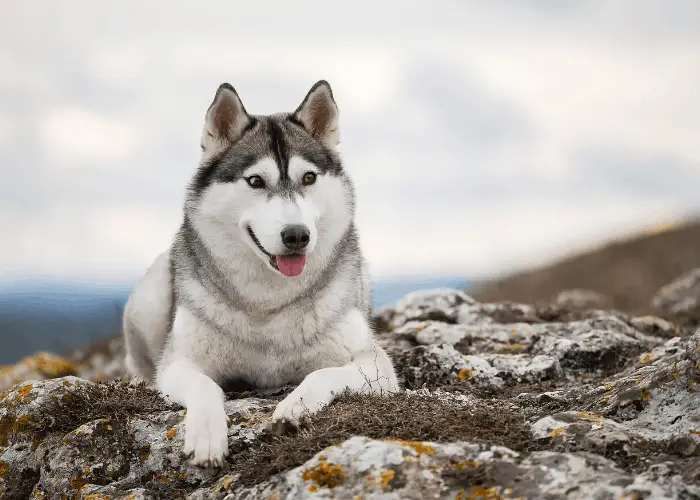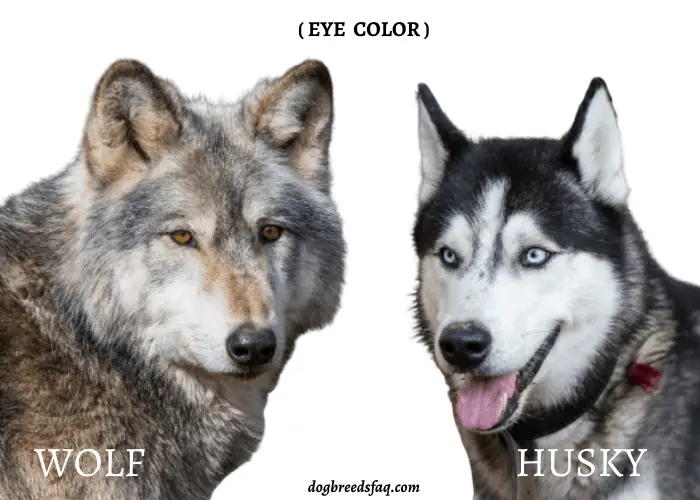When it comes to wolf vs. Husky differences, sometimes there can be slight.
Let’s take a look at the wolf vs. Husky comparison chart:
[table id=88 /]
As you can see, there are several differences between wolves and huskies.
Most notably, wolves can grow to be much larger than huskies, sometimes doubling or even tripling them in weight.
They also have different eye colors, and their coats are evolved for various living environments.
There’s no doubt that huskies and wolves bear a very similar appearance, and from a distance, they can be difficult to tell apart.
But while huskies and wolves look very similar, they are actually two very distinct breeds of animals.
A husky is a dog, and a wolf is a wolf. It’s their shared ancestry that makes them look so similar.
But what does the history of the wolf and the husky look like?
Today we will dig deeper and answer all of this questions and more, so let’s not waste another minute.
Is Husky a Wolf?

Is Husky a wolf? No.
In fact, the Husky is no more related to the wolf than French bulldogs and American bulldogs.
So why do the two look so similar?
The answer comes down to science and DNA.
First of all, let us say that when it comes to genetics, wolves are closer to other wolves than they are dogs, and dogs are closer to all different breeds of dogs than they are wolves.
But that doesn’t mean that they don’t share some of the same ancestries.
While it was once suspected that dogs evolved from wolves, it’s recently been found that a more likely explanation is that both wolves and dogs evolved from a common ancestor – one that is now extinct.
Are Wolves and Huskies Related?
The separation of dogs from their common wolf-like ancestors is believed to have taken place around 27,000 years ago.
When domestication of dogs took place, however, it is unknown. With that being said, dogs and people have been found buried together over 14, 000 years ago.
Today, according to a study, huskies and wolves share 98.8% of the same mitochondrial DNA but are still very two distinct breeds of animals.
Still, this is a good explanation for why the two look so similar in appearance.
History:
Siberian Husky:

The Siberian Husky, as you may have guessed, is native to Siberia in Russia. The breed was originally developed by the Chukchi people and was commonly used to aid in hunting, as well as for pulling sleds.
Huskies were the perfect breed for the harsh climates of the Siberian Arctic and were able to pull large loads across long distances. During this time, Huskies were highly valued by the Chukchi people.
Up until the 1900s, Siberian Huskies were not well known throughout other places in the world, but in 1925 they made headlines and attracted worldwide attention.
During this time, a relay of Siberian Huskies traveled over 650 miles in less than six days to deliver serum to Nome, Alaska, which was having a Diptheria epidemic.
Since that time, Siberian huskies became a popular dog in the US, as well as in other areas of the world.
Wolf:

The truth is that the exact history of the wolf is unknown. With that being said, many biologists believe that they descended from a now-extinct breed known as miacidae.
These carnivores were believed to live over 52 million years ago and ranged from the size of a gopher to the size of a large dog.
Where the wolf originated is also unknown. Some believe that canids originated in North America and eventually spread to South America and Asia.
Others believe that they originated in Alaska, moved into Siberia, and then migrated to North America.
Wolf vs Husky Size & Weight Comparison

Husky vs Wolf Appearance
Huskies and wolves are often mistaken for one another due to their similar appearances.
The main similarity between the two is their thick fur.
Both wolves and Siberian huskies have a thick, double coat of fur that helps to protect them in cold climates.
In addition, they both have similar facial markings and colorings, which is why they are often confused with one another.
With that being said, there are some marked differences between huskies and wolves too.
Temperament:

The main difference between wolves and huskies are their temperaments.
Though wolves might look much like dogs, it’s important to remember that they are wild animals.
Even though they look like a husky, they should never be approached.
Wolves are dangerous animals that have not been domesticated and are likely to attack.
WORTH A LOOK: wolf bite force
Siberian Huskies, on the other hand, are domesticated animals.
In most cases, they are extremely friendly. They are affectionate and loving animals that crave human attention.
Because they crave human attention, Siberian Huskies are also very trainable. With a little bit of attention and some good treats, Huskies can be taught to do a variety of tricks like sit, fetch, lay down, and so on and so forth. In other words, they are like any other dog.
Wolves, on the other hand, are not domesticated and are not easy to train. Though many people have tried to own and tame a wolf, the results are not usually promising.
Wolves reach maturity and become independent at a very young age, making them very difficult to control. For this reason, they don’t take to training well.

In terms of intelligence, Huskies are a very smart breed of dog, but wolves take the win. Even though they are less trainable, wolves are considered to be much more intelligent and smarter than Huskies.
Finally, wolves and Siberian Huskies are different in the fact that wolves are pack animals.
Wolves are known to hunt with other wolves and don’t do well when singled out on their own.
And because wolves rely on other wolves to survive in the wild, they don’t do well in human families. Siberian huskies are similar in that they are pack animals, but they are okay having a human as part of their pack.
With a strong, alpha owner, huskies can do very well in a family environment.
And finally – the howl. Wolves are mostly known for their howls, but it may surprise you to know that they often bark a lot too.
Siberian huskies, on the other hand, don’t bark often. Rather, they just tend to howl.
Final Thoughts

In conclusion, wolves and Huskies may look similar, but they are actually two very distinct breeds of animals.
Here Is The Summary Of Their Differences:
- Huskies are domesticated animals and wolves are not.
- The Husky is a large dog but is nothing in comparison to the more massive wolf who can grow to be up to 200 pounds.
- The Husky can take on a variety of different colors of fur; wolves tend to stay in the gray and white regions.
- Wolf’s eye color is yellow; husky is blue, black, brown, green, amber, sometimes bi-eyed color.
- Wolves are considered more intelligent and smarter than Huskies.
- Siberian Huskies are very trainable; wolves are not.
- Wolves can adapt and survive in different climates, whereas the Husky cannot survive in hot environments.
- Huskies can live to a maximum of 15 years compared to wolves’ lifespan of 8 years in the wild.
- Wolves are found in North America, Europe, Asia and North Africa; Huskies can be found anywhere in the world(globally).
Furthermore, it’s important to note that Siberian Huskies are legal and safe to keep as pets.
Keeping a wolf as a pet is not only illegal but also extremely dangerous.
Do not confuse the two – one is domesticated, and the other one is wild.
You’ll find more dog pros and cons questions in the links below:

